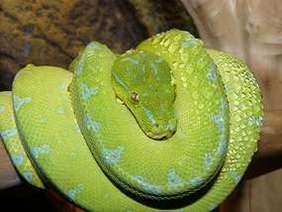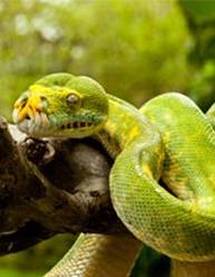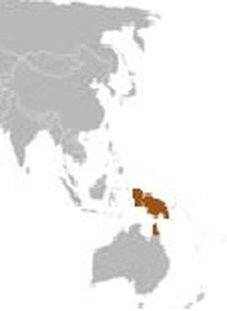Green Tree PythonMorelia Viridis |

Custom Search
|
|
The green tree python (Morelia viridis) is really a wonderfully colored constrictor snake which lives throughout tropical rainforests of New Guinea, Cape York Peninsula in Australia, Solomon Islands as well in some islands in Indonesia. It is also found in Florida, where it is considered an invasive species, just like the Burmese python and the African rock python.
The green tree python usually inhabits tropical rainforests but also be found in secondary forests and re-growth areas ranging from sea level up to 2000 m in altitude. The green tree python shares its habitat with other python species like the carpet python (Morelia spilota). The Green tree pythons spend most of their life within the trees, climbing down only when they would like to look for a different tree. They spend much of their time coiled over branches with their head resting in the middle of the coils. They have a slender shape and a prehensile tail which enables them to move around between the branches of trees. Their head is large and is much wider than their body. The scales around their mouth have also thermoreceptive pits to help detect prey similar in function to those of pit vipers. This snake usually reaches a total length of around 5 to 6 ft (150 to 180 cm), but some larger females may reach up to 6,6 ft (200 cm), their size also can vary based on the place of origin. Their weight is dependent on their nutritional status, the males can weigh about 2.4 to 3.1 lb (1,1 to 1,4 Kg) and females up to 3.5 lb (1,6 Kg). Like most snake species females are slightly larger and heavier than males, and especially large specimens can weigh up to 4.9 lb or 2,2 Kg.

They are known to bite when provoked, they become easily agitated and very protective.
The males are more aggressive in the mating season and the green tree python females become more aggressive when they are protecting their eggs. Its expected lifespan is normally around 2 decades while in the wild or approximately 35 years in captivity. The green tree python is prey to several animals including black butcherbirds, raptors, rufous owls, dingoes, New Guinea quolls, and mangrove monitors. Although the green tree pythons possess a one of a kind physical appearance they look very similar to the emerald tree boa (Corallus caninus) of South America, and in captivity it's very easy to confuse them. The green tree python is a very popular snake species among reptile collectors and is often kept as exotic pets. In the herpetoculture hobby, they are also known as "chondros", because of the species former classification in the genus Chondropython. Although they are very often kept and bred in captivity, due to their somewhat specific care requirements the green tree python is usually considered an advanced species best suited to more experienced reptile enthusiasts. Diet / Feeding
Their diet is comprised largely of small mammals, which include rodents, as well as in some cases reptiles. This snake species, much like the emerald tree boa, it was thought to eat mainly birds, but no scientific evidence of this was found so far. Green tree pythons capture their prey by holding onto a branch using the prehensile tail and striking out from an s-shaped position and constricting the prey. Reproduction The species reproduction has never been reported in the wild, most available information on their reproduction comes hobbyists in the pet trade. We do know that the species is oviparous, and lays around 6 to 30 eggs per clutch in a tree hole or among plants, up to 24 days after the mating occurs. The breeding process has never been reported in the wild, however, in captivity, the eggs are always incubated and protected by the female. After a period of 45 to 52 days the eggs hatch, the young snakes become immediately independent. The hatchlings are lemon-yellow color with stripes and spots of purple, brown, golden or orange-red and measure about 1 ft (30.5 cm) in length. As the hatchlings mature they become green, which normally occurs between 6 to 8 months old. The species reaches sexual maturity at 2 to 4 years and has a breeding interval of 1 year. When they are young, the green tree pythons are hunted by birds of prey. Conservation / Threats Humans, like in many other cases are the main threat to the green tree python, mainly as a consequence of habitat destruction due to the logging industry that continues to clear out areas where they inhabit. Being one of the most common pythons found in the international pet trade is often collected from the wild. New Guinea Indigenous people also hunt them for food. Even so, their conservation status by the IUCN is listed as "Least Concern". The green tree python is also listed on Appendix II of CITES.
|
Did You Know?
In colder climates some snakes "hibernate" in the winter, this is called brumation, find more snake facts for kids. Scientific classification |
© 2014 Snake Facts About Us | Privacy Policy | Contact




